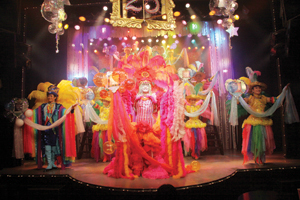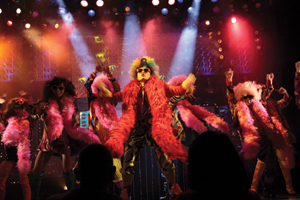Anmitsu Hime 「あんみつ姫」
|
“Go once, and you’re hooked,” or so everyone says. My interest had been piqued for some time, but for this transvestite show virgin, my curiosity was tinged with a little… trepidation, maybe? Negotiating that inner tug-of-war, I dropped in to Anmitsu Hime. It’s conveniently located in the center of Fukuoka, on Tenjin’s famed Oyafuko-dori (Street of the Wayward Child). It was Sunday night, the streets outside were quiet, but inside.. …it’s a completely different world! The boisterous scene is fueled by the laughter of guests, male and female, young and old alike. Before long, the show starts. Like some condensed version of Takarazuka, the well-timed dancing in gaudy outfits flows in to comic skits, Japanese dancing and, well, sexiness—it all translates into a smorgasbord of delight for everyone. After the show, I spoke with “Tomato,” the troupe leader. Koe: This is quite a unique theater, but what are its origins? Tomato: I am the 4th troupe leader in its history, but when it opened about 25 years ago, so-called “show pubs” were popular among the public. Anmitsu Hime was just trying to ride that wave. But even with the dancing, it wasn’t like we were simply imitating; we learned real moves and practiced hard, creating a show that guests could truly enjoy. That spirit, formulated by our first troupe leader, is still with us today. K: What kind of changes have you seen over these 25 years? T: We were once perceived as a “show pub” or “gay bar,” but now people recognize us as a performance theater. Of course, the road to that recognition was a long one. Our customers have changed a lot, too. Just as we were entering the bubble period of the 1980s, the tips from customers started growing considerably and it was a time of giddy excitement. We were increasingly asked to perform at events for companies, too. When the bubble eventually burst, many of those around me disappeared without a trace… and the people who climbed the social ladder on the back of the bubble just suddenly vanished, too. Before, we had bought most of our clothing and equipment, but after the bubble, we had to make it all ourselves. In a way you could say that we owed our more responsible attitude of conservationism to the decline. As for the customers, there were a lot of older women and not too many youth. It was also common to see businessmen bringing young female staff. But now there are quite a few young women who come with their female friends. Likewise, we didn’t see many men coming together before, but that’s changed, too.
K: Do you have any interesting anecdotes? T: One performer got dragged back to his hometown when it was discovered he worked here. Then there was a kid with gender identity disorder who came in, saying stuff like, “I want to become a fairy.” I ran into him the other day after a considerable absence—he’s just your average old guy with a beard now. Some customers come in wanting to talk to us about marriage or divorce. I distinctly remember going to a wedding party where I was invited to be the emcee for a couple that had met at Anmitsu Hime. K: What’s Anmitsu Hime’s role as a tourist destination? T: There are tons of theaters and establishments in Tokyo and Osaka doing interesting stuff everyday. There’s a large theater in Fukuoka, but there aren’t so many relatively smaller theaters where you can just go and expect to see something interesting. Anmitsu Hime has always tried to function as that smaller theater. Our idea was to have a place where you can go anytime and let it all out with laughter. We want to present entertainment that youth can enjoy or that parents and children can enjoy together like a theme park. Also, laughter in Kanto, Kansai and Hakata is different. But regardless of locality or dialect, a show that people across the country can enjoy, a show that even foreigners the world over can laugh at, a show where you can simply look and laugh and not have to think anything at all—that’s the kind of entertainment we strive to create. At present, Anmitsu Hime is celebrating its 25th anniversary with an array of special events. For more information, refer to their website: www.okama.com |
一度行ったらハマる、みんなそう言うから前から気にはなっていた、そんな「オカマ」さんのショー初体験の僕は好奇心とちょっとの恐怖心?を感じながら「あんみつ姫」に向かった。福岡の中心、天神の親富孝通りという便利な立地。日曜日の夜で通りは静かだったが・・・ 劇場に入るとそこはまったくの別世界。老若男女たくさんのお客さんの笑い声で大変な賑わいだ。やがてショーが始まると・・・宝塚を凝縮したような、きらびやかな衣装と切れのあるダンスが続き、さらにコントあり、日舞あり、お色気あり、なのでまさに老若男女楽しめる絢爛豪華なエンターテインメントになっている。ショーを終えた「座長とまと」さんに話を聞いた。 Koe:とてもユニークな「劇場」ですが、始めたきっかけは? とまと:私は4代目の座長なのですが、25年前の開業当時、ちまたでは「ショーパブ」という業態が流行りだした頃で、あんみつ姫もその波に乗ってスタートしました。ダンスも誰かの見よう見まねではなく、きちんと習って練習を重ねてそうして出来上がったものをショーとしてお客様に楽しんでいただく、そういうスタンスを作ってくれた初代座長の精神は今に受け継がれています。 Koe:25年間でどんな変化がありましたか? とまと:かつてはいわゆる「ショーパブ」「ゲイバ-」として見られていましたが、今では「劇場」として認知されています。そこに至るまでには長い道のりがありましたが。 お客さんのほうも随分変わりましたよ。いわゆるバブル期に入った頃はお客様から頂くご祝儀も桁違いに増えてきて、イケイケドンドンな感じでした。会社関係の行事への出演依頼も増えました。やがてバブルが終わると私の周りでたくさんの人が消息不明になって・・・バブルの力で成り上がった人たちがいつの間にか消えていったのです。また、私たちが使う衣装や大道具なども以前は買っていたものがバブル崩壊後は自分たちで作るようになりました。モノを大事に使う素直な気持ちが生まれたのはバブル崩壊のおかげと言えます。 客層については以前はオバチャマが多く、若い子はあまりいませんでした。サラリーマンが女性社員を連れてくるパターンはありましたが。今では若い女の子同士で来られるお客さんがたくさんいらっしゃいます。また男性同士というパターンも以前はほとんどなかったのですが今では結構多いです。 Koe:面白いエピソードなどありましたら教えてください。
とまと:親にバレて実家に連れ戻された従業員がいました。あと、性同一性障害の子が入ってきて Koe:あんみつ姫の「観光スポット」としての役割は? とまと:東京や大阪には毎日面白いことをやっている劇場やお店がたくさんあります。福岡には大きな劇場はありますが、比較的小規模でいつ行っても何か面白いことをやっているような劇場が少ないですから、あんみつ姫はずっとそんな劇場を目指してきました。いつ行っても理屈抜きに笑えるような場所が理想です。そしてテーマパークのように親子で楽しめる、若い人たちも楽しめるエンターテインメントを提供していきたい。 そして、関東の笑い、関西の笑い、博多の笑いはそれぞれ違いますが、土地柄や言葉・方言に関係なく全国共通で楽しめるもの、さらに万国共通で外国人のお客様も笑えるようなショー、何も考えないで見ただけで笑える面白いショーを作っていきたい。 現在あんみつ姫では25周年キャンペーンとして楽しいイベントをいろいろ実施中。あんみつ姫ウェブサイト:www.okama.com
|











